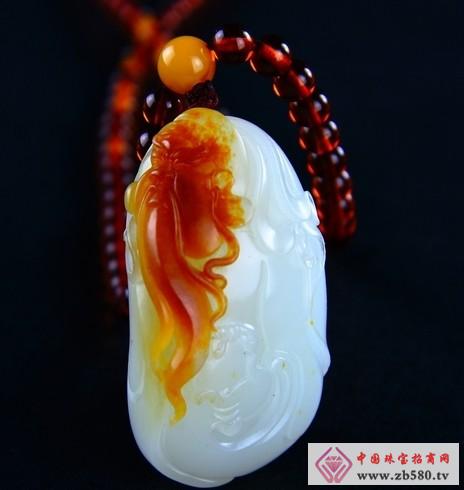Hetian jade pendant identification
The identification of Hetian jade pendant is nothing more than the jade material and the fine workmanship, which determine the value and artistic level of a jade pendant. The average consumer may not see the process, so at least to identify the jade raw materials, the following small series will tell you the identification of the Hetian jade pendant.

First, the color
All kinds of jade are attracted by the natural color of their own characteristics, and they are on the list of world treasures. Jade connoisseurs attach great importance to color. Color is not only an important criterion for evaluating the quality of Hetian jade, but also the main basis for the classification of Hetian jade. The color of Hetian jade is the leader among all kinds of jade, and is cherished with its unique jade color.
The color of Hetian jade is more than that of soft jade in other regions at home and abroad. Hetian jade has four basic colors: white, cyan, yellow, black, and some transition colors, such as white, gray, and so on. Hetian jade has rare white jade in the world, especially the color of the fat-white sheep white jade is unique to Hetian jade, extremely valuable. In addition, Hetian jade has a variety of skin colors. Many jade in the world have this color, but it is not as beautiful as Hetian jade. In particular, Hetian jade has a lot of jade skin, and has autumn pear, aloe, jujube, black and so on. The jade artist has a variety of leather colors with the name of jade, such as autumn pear skin, tiger skin, jujube skin, black skin and so on. The skin color can be used to make a pretty jade, which is naturally interesting. From stone to the present, the jade is very expensive and the jade is called, it is called Debao.
Second, the hardness
Hardness is one of the important signs for identifying Hetian jade. The hardness of a mineral is a mechanical property of minerals invading other objects. There are usually two ways to express hardness:
(1) Relative hardness, or Mohs hardness, is a kind of scoring hardness.
(2) Absolute hardness, also called indentation hardness. It is measured according to the weight that can be withstood on the surface of the mineral.
Hetian jade has a Mohs hardness of about 6.5, which is slightly different. In general, the hardness of sapphire is slightly larger than white jade Hardness is generally used as an important symbol for the division of gems and jade in the jewellery industry. Gem hardness is generally above 7 degrees Mohs, jade hardness is generally 4 to 7 degrees Mohs, and Mohs 4 degrees or less is often called colored stone or carved stone. The hardness is high and the polishing property is good, which makes the jade bright and easy to store.
Third, resilience
Resilience is usually the inherent ability of jade to combine, that is, resistance to external pressure or crushing force. The characteristic of toughness is that it is not easy to be broken and wear-resistant. The world's most resilient mineral is black diamond. For example, black diamond is 10 degrees. The toughness of other gemstones is relatively: jade is 9 (nephrite); jade, ruby ​​and sapphire are 8; diamond, crystal and aquamarine are 7 ~7.5 and so on. For example, the toughness of nephrite is 1000, and the toughness of other minerals or rocks is relatively: jadeite (Jadeite) 500; serpentine 250. The soft jade has a great toughness, which is not found in other jade. Hetian jade has a large toughness and can be used for fine workmanship. The jade jade hand can make fine work on Hetian jade without being easily damaged.
Fourth, transparency
Transparency is the extent to which jade allows visible light to pass through. This is mainly related to the absorption of light by jade. Mineralogy is generally divided into three types: transparent, translucent and opaque. In the jade industry, transparency is important. There are special terms, such as "water head foot", "land child spirit" or "pit spirit". The poor transparency is called "no water head" and "land stuffy stuff". "Pit stuffy." To determine the transparency, the jade should be polished, and under certain thickness (jade products), look at other objects, and divide into four levels: transparent body, translucent body, micro-transparent body, and non-transparent body. Hetian jade is a micro-transparent body that transmits light under normal aggressiveness, but does not see through the image.
Five, luster
Gloss is the ability of jade to reflect light. Hetian jade is a grease luster. The ancients called Hetian jade "warm and zeal", that is, its luster has a very slick oiliness, giving people a feeling of moisturizing. This kind of luster is very soft, not strong and not weak, that is, there is no crystal inspiration of glare, and there is no waxy texture of weak light, which makes people look comfortable and touch the beauty. The fingering jade is named for its fat, which is very good, very moist and very precious.
6. Weight
The weight is the weight per unit volume of jade. Hetian jade's body weight was determined by small body weight, which was 2.66 to 2.976. There are slight differences between the different varieties, white jade is 2.922, green white jade is 2.976, and ink jade is 2.66. Generally, white jade weighs less than green or blue and white jade, and jade is lighter because it contains lighter graphite scales.
Hetian jade pendant If the texture is beautiful, the workmanship is exquisite and meticulous, then the value is definitely not cheap, but for a penny, the good goods must pay a high price. However, if you have mastered how to identify the Hetian jade pendant, you can choose the product with the true value.
Cotton Cloth,Solid Cotton Fabric,Cotton Fabric With Solid,Solid Print Cotton Fabric
Changxing Xingang Textile Co.,Ltd , https://www.xingangtextile.com